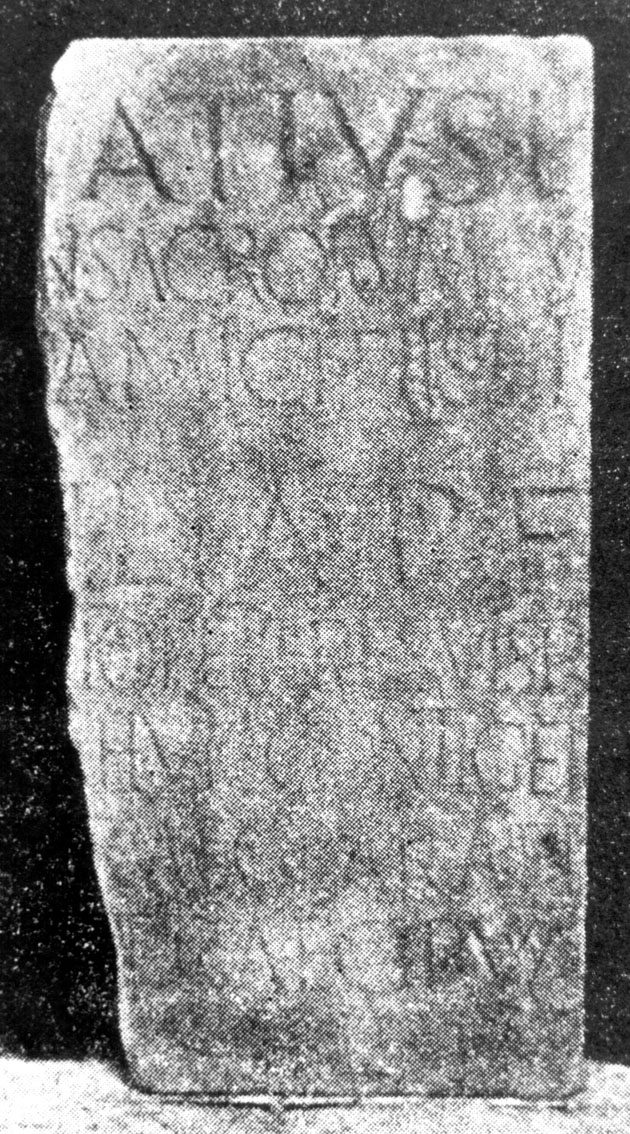Epitaph of the flamen Lucius Attius and Emilia
Reference CIL II2/5, 330 | Description | Lyrics | Location | Chronology | Epigraphic edition | Translation | Apparatus | Comentary | Type of verse | Text divided into verses and metric signs | Images | Bibliography | Link to DB | Author |
Epitaph of the flamen Lucius Attius and Emilia
Description
- Idno filename 22/01/0093
- Type of inscription: Sepulcralis
- Material Description: Fragment of a white marble plate.
- Conservation status: Has lost its two sides.
-
Epigraphic field:
- Layout: The layout is good. Triangular interpunctions separate each word, except after (vo)to (l.5); hederae in l. 1 to separate words. Stylow edited vacat at the beginning of the pentameters (ll. 6 and 8); but in order to complete l. 8 there are four or five letters missing on the left, what would not leave space for indenting; if this second pentameter lacks a vacat or an indenting, we consider that the same happens with the first pentameter (l. 6).
- Lost
Lyrics
- Font:Capital cuadrada
- Description of the letters:The size of the letters is bigger in the prose (ll. 1-3) than in the carmen (ll. 4-9); in ll. 1 and 4, where the names of the deceased are recorded, they are bigger than in ll. 2-3-.
Location
- Place of discovery: It was found in 1903 by D. Joaquín Urbano, vecino de Cabra, … en el pago nombrado Fuente de las piedras, Albornoz, al pie del cerro que llaman la Atalaya Fita (J. Urbano, resident of Cabra, ... in the village called Fuente de las Piedras, Albornoz, at the foot of the hill that people call the Atalaya Fita) 2 km away from the village of Cabra (Córdoba), near a rustic villa where a effigy of Mitra tauroctono was found (Stylow).
- Geolocation
- Location with Modern Nomenclature España / Córdoba / Cabra
- Location with Old Nomenclature Hispania / Baetica / Astigitanus / Igabrum
Chronology
- Inscription's dating: Between year 1 and year 99
Type of verse
- Type of verse: Dactílico (ritmo)
- Verse/line correspondence: Si
- Prose/verse distinction: Si
Epigraphic edition
[L(ucius)? ❦] Atius ❦ L(ucii) ❦ [f(ilius) —]
[flame]n ▴ sacrorum ▴ pu[b(licorum) ann(orum) —]
[caru]s ▴ amicitiis ▴ hic̣ [▴ situs ▴ est ▴ s(it) ▴ t(ibi) ▴ t(erra) ▴ l(evis)]
[-3?-]ilia ▴ P(ublii) ▴ f(ilia) [ann(orum) —]
5 [quod vo]to petiere ▴ suis ▴ p[lerumque parentes]
[cuncta] ▴ huic ▴ contiger[ant -ca.13-]
[lanifici] praeclara ▴ fi[des pietatis alumna]
[prisca] praecipua[e fama pudicitiae]
h(ic) [s(ita)] e(st) [s(it) ▴ t(ibi) ▴ t(erra) ▴ l(evis)]
Text divided into verses and metric signs
Quod voto petiere suis plerumque parentes qq|q/kk|qk/k|q/q|qkk|qx
cuncta tibi dignae, Caesia, contigerant: qqqkkq/[qkkqkkx]
lanifici praeclara fides, pietatis alumna, qkk|q/q|qk/k|qkk|qkk|qx
priscae praecipue fama pudicitiae. qqqkkq/qkkqkkx
Translation
Lucius? Atius [---], son of Lucius, flamen of public sacrifices, aged [---] years; dear to his friends, here he lies, may the earth be kind to you. [---], daughter of Publius, aged [---] years. That which parents often ask for their own by a vow, to this one all had been granted... Distinguished example in the work of wool, nourished with piety, ancient fame of an outstanding modesty. Here she lies, may the earth be kind to you.
Bibliography
Cagnat 1904, 349-350, ex Paris scheda; Fita 1908a, 40-42 cum im. phot. ab Albornoz praebita (inde Albornoz 1909, 40-42; Segura 1988, 180); Stylow, II2/5, 330 (inde Cugusi 2012, 47); Bolaños-Fernández Martínez 2017, 127-134 cum im. phot. — Cf. Thouvenot 1940, 293; Castillo 1993, 84-85; Velázquez Soriano 1996, 98-99; Hernández Pérez 2001a, 151.
Apparatus
Carmen supplevimus ex J17.
1 [—]natius Cagnat et coni. [Mu]natius?; L · HORATIVS · L · F · VICTOR Fita; hederam post L(ucii) Cagnat ed. tantum; filius suppl. Cagnat et Fita; in hoc v. tantum cognomen adest. — 2. [flam]en suppl. Cagnat et Fita; CV Cagnat ed., et inde coniecit cu[rator?]; PVB · M· I (pub(licorum) m(unicipii) I(gabrensis)) Fita, pu[blicorum] suppl. Stylow; ann(orum) supplevimus. — 3 carus] et [situs est suppl. Cagnat, post haec cet. addimus, ubi [-7?-] Stylow; HIC · S · E Fita. — 4 IVLIA Fita, [-3-4-]ilia Stylow. — 5 CALLIOPE · HERES · VI · S · P · C (v(iro) s(uo) p(onendum) c(uravit) Fita, [quae vo]to Cugusi. — 6 [(vac. 3) vix] stat. et suppl. Stylow, [vix] Cugusi; HVIC · CONTIGET tantum Fita; contiger[ant] suppl. Stylow. — 7. [priscae] supplevimus, cet. suppl. Hernández; p]raeclara · fi[de Stylow; FVNERA · PRAECLARA · FIERI Fita. — 8. Litt. prima inedita; [(vac. 3) -3?-] Stylow stat.; praecipua ut initium v. fuisset ed. Cugusi; ET · PRAECIPVA Fita. — 9. L · D · D · D (Lo(cus) d(atus) d(ecreto) d(ecurionum)) Fita.
Comentary
Until now, plate thought to be dedicated to the flamen sacrorum, whose name heads the inscription, and the name that appears in l. 4 was supposed to be that of the dedicant; however, since the name of both is in nominative, we should think that the inscription is dedicated to two deceased; after the normal funerary formulae in inscriptions from the Baetica, before the second name, the interlineal space is considerably bigger than in the rest of the inscription, where they are completely regular; moreover, all its editors, excluding Fita, have omitted the existence of a possible last writing line: between the A and the E of the eighth line we can guess a H, between the P and the V, the remains of what seems a E; this could likely correspond to the formula H(ic) S(ita) E(st), which we should complete in the lost fragment of the right side with S(it) T(ibi) T(erra) L(evis), all of it spaced, in order to occupy the entire writing line, respecting the good general layout that it presents; the poor quality of the only preserved picture prevents us from confirming this hypothesis.
The reconstruction of the left side of l. 2 is certain, based on another epitaph of the Baetica (II2/7, 68, Ugarvo); if we take into account that in this line we have lost 5 letters, and that each letter in l. 1 encompasses approximately two letters in l. 2, there is enough space in l. 1 to reconstruct 2 or 3 more letters. All attested nomina finished in –atius have, at least, three more letters (Egnatius, Horatius, Munatius…). Therefore, the nomen of the deceased must have been Atius, whose presence is attested in Baetica and other places in Hispania (cf. Abascal 1994, 289); so that the praenomen has been lost, as it probably happened with a hederae as well, as we can see in the rest of the line. The lacuna on the right side must have been occupied by F(ilius) and maybe the cognomen of the deceased.
Although the formula amicitiis (l. 3) is not attested in any other inscription, it seems plausible to reconstruct carus before it, common formula in epitaphs of the Baetica (cf. II, 1763: amicis carus et suis, or II, 1770: carus suis et amicis). The formulae H(ic) S(itus/a) E(st) and S(it) T(ibi) T(erra) L(evis) appear together recurrently throughout Hispania, therefore, there is no doubt that this must have been what completed the text on the right side. In l. 4 there are 2 or 3 letters of the nomen of the deceased missing. We have reconstructed Aemilia since this is the most attested possibility in Baetica, as well as in nearby settlements to Igabrum (cf. Abascal 1994, 67); nevertheless, there are other possibilities, such as Atilia, Manilia, Acilia, Anilia, Avilia, Petilia, also attested in Baetica (cf. Abascal 1994, 86, 179, 63, 76, 92 and 197 respectively). On its right side there is no space for a cognomen, only for Ann(orum) and the age.
Between ll. 5 and 8 there is a carmen, made up by elegiac distichs, respecting the verse boundary: it coincides in ll. 5, 7 and 8 with J17, specifically with the sequences before caesura penthemimeres (ll. 5 and 7) or before dieresis (l. 8). In that verse in J17 there appears the name of the deceased, Cesia, what has caused changes on it, although it seems to have used similar expressions (contiger[ant); instead of addressing the dedicatee in the second person (tibi), it does it in the third, using the deictic huic, what, very probably, indicates us that the name was not part of the verse.
In l. 6, we have only lost the first element of the first foot on the left side. Thus, Stylow suggested to read vix and thought that the pentameters were indented. However, having taken into account that l. 8 is missing an entire foot, as well as the characteristics of the layout mentioned above, it seems preferable to reconstruct cuncta, the same that can be read in J17, whose synalepha with huic provides us with a unique long element. As Cagnat suggested, contigerant seems to be an adequate ending for a pentameter; before dieresis appears in Ovid (met. 11,268 y 12,194), unlike in contigerunt, reading traditionally suggested for J17. This metric parallel could perhaps indicate that this inscription served as inspiration for J17, disrupting this second verse to insert the name and not the other way around.
Schader (in Burmann 1759-1773 II, 214, book IV, no. 277), in relation to J17, suggested to correct quod quae; also Cugusi in regard to CO73. In this case, the expression of this first verse is close to one of a prototypical formulation of the topos that “the parents have done what their children should have done as well” (cf. Hernández Pérez 2001a, 1-8 and CLE 166-176), precisely unethical compared to the one we are studying. The consequence is, in fact, a concordance ad sensum which does not require to be amended.
The two remaining verses make up a laudatio of the deceased through subjects usually related to women: working with wool (lanifici praeclara fides), and self-love (pudicitiae), highlighting her relationship with the traditional Roman moral (mores maiorum): pietatis alumna, priscae…, and it has echoes in Virgil: heu pietas, heu prisca fides… (Aen. 878). The clause of the second verse is an adaptation for a woman in Ov. met. 14,443, taken from the faked epitaph of Anenas’ nursemaid, Cayeta, ant it appears, also without being adapted in CLE 12,3; the ending of the last verse is inspired by Prop. 1,15,22: …Argivae fama pudicitiae. Praecipua instead of praecipue (J17,6), would cause a brevis in longo before dieresis of the pentameter; the syntagma praecipua fama is not attested in antiquity,unlike prisca fama: priscae titulos praecedite famae (Stat. silv. 2,146) which is documented; close expressions can be found in Virgil: …prisca fides facto, sed fama perennis (Aen. 9,79), and Martial: …prisca fides famaque novit anus (ep. 1,39,2).
Author
- Author:A. Bolaños Herrera, C. Fernández Martínez
- Last Update2024-02-17 18:01:31
You can download this





